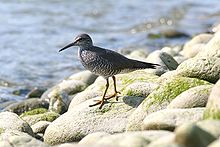
The common redshank or simply redshank is a Eurasian wader in the large family Scolopacidae.
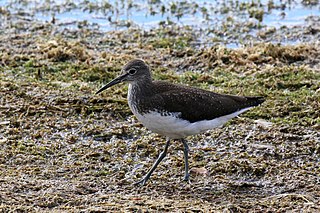
The green sandpiper is a small wader (shorebird) of the Old World.

Tringa is a genus of waders, containing the shanks and tattlers. The genus name Tringa is the Neo-Latin name given to the green sandpiper by the Italian naturalist Ulisse Aldrovandi in 1599. They are mainly freshwater birds, often with brightly coloured legs as reflected in the English names of six species, as well as the specific names of two of these and the green sandpiper. They are typically associated with northern hemisphere temperate regions for breeding. Some of this group—notably the green sandpiper—nest in trees, using the old nests of other birds, usually thrushes.

The willet is a large shorebird in the family Scolopacidae. It is a relatively large and robust sandpiper and is the largest of the species called "shanks" in the genus Tringa. Its closest relative is the lesser yellowlegs, a much smaller bird with a very different appearance apart from the fine, clear, and dense pattern of the neck, which both species show in breeding plumage. It breeds in North America and the West Indies and winters in southern North America, Central America, the West Indies and South America.

The greater yellowlegs is a large shorebird in the family Scolopacidae. It breeds in central Canada and southern Alaska and winters in southern North America, Central America, the West Indies and South America.

The lesser yellowlegs is a medium-sized shorebird. It breeds in the boreal forest region of North America.

The gull-billed tern, formerly Sterna nilotica, is a tern in the family Laridae. It is widely distributed and breeds in scattered localities in Europe, Asia, northwest Africa, and the Americas. The Australian gull-billed tern was previously considered a subspecies.
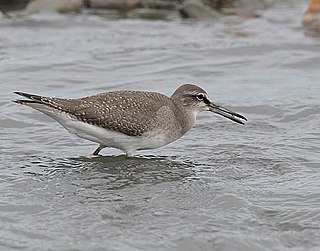
The grey-tailed tattler, also known as the Siberian tattler or Polynesian tattler, is a small shorebird in the genus Tringa. The English name for the tattlers refers to their noisy call. The genus name Tringa is the Neo-Latin name given to the green sandpiper by Aldrovandus in 1599 based on Ancient Greek trungas, a thrush-sized, white-rumped, tail-bobbing wading bird mentioned by Aristotle. The specific brevipes is from Latin brevis, "short", and pes, "foot".

The yellow bittern is a small bittern. It is of Old World origins, breeding in the northern Indian Subcontinent, east to the Russian Far East, Japan and Indonesia. It is mainly resident, but some northern birds migrate short distances. It has been recorded as a vagrant in Alaska and there is a single sighting in Great Britain, from Radipole Lake, Dorset on November 23, 1962 – however, the British Ornithologists' Union has always considered this occurrence to be of uncertain provenance and currently it is not accepted onto the official British List.

The black-faced cuckooshrike is a common omnivorous passerine bird native to Australia and southern New Guinea. It has a protected status in Australia, under the National Parks and Wildlife Act, 1974.

The Pacific black duck is a dabbling duck found in much of Indonesia, New Guinea, Australia, New Zealand, and many islands in the southwestern Pacific, reaching to the Caroline Islands in the north and French Polynesia in the east. It is usually called the grey duck in New Zealand, where it is also known by its Maori name, pārera.

The surfbird is a small stocky wader in the family Scolopacidae. It was once considered to be allied to the turnstones, and placed in the monotypic genus Aphriza, but is now placed in the genus Calidris.

The bristle-thighed curlew is a medium-sized shorebird that breeds in Alaska and winters on tropical Pacific islands.
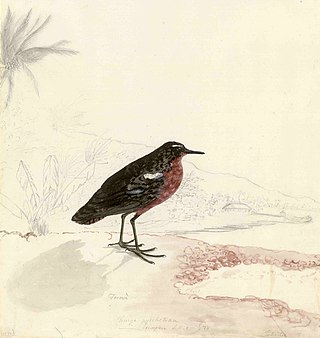
The Tahiti Sandpiper or Tahitian Sandpiper is an extinct member of the large wader family Scolopacidae that was endemic to Tahiti in French Polynesia until its extinction sometime before 1819.

The whiskered auklet is a small seabird of the auk family. It has a more restricted range than other members of its genus, Aethia, living only around the Aleutian Islands and on some islands off Siberia, and breeding on these islands. It is one of the smallest alcids, only the closely related least auklet being smaller. Its name is derived from the long white feathers on its face that are part of its breeding plumage.
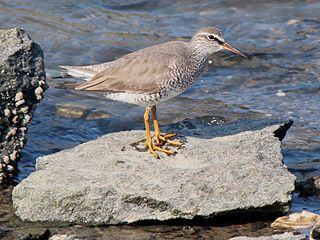
The tattlers are the two very similar bird species in the shorebird genus Tringa. They formerly had their own genus, Heteroscelus. The old genus name means "different leg" in Greek, referring to the leg scales that differentiate the tattlers from their close relatives, the shanks.
The Phoenix petrel is a medium-sized tropical seabird, measuring up to 35 cm (1.15 ft) long, with a wingspan of 83 cm (2.72 ft). It has a dark brown upperparts plumage, white below and whitish throat. The sexes are similar.

The Antarctic tern is a seabird in the family Laridae. It ranges throughout the southern oceans and is found on small islands around Antarctica as well as on the shores of the mainland. Its diet consists primarily of small fish and crustaceans. It is very similar in appearance to the closely related Arctic tern, but it is stockier, and it is in its breeding plumage in the southern summer, when the Arctic tern has shed old feathers to get its non-breeding plumage. The Antarctic tern does not migrate like the Arctic tern does, but it can still be found on a very large range. This tern species is actually more closely related to the South American tern.

The Christmas sandpiper or Kiritimati sandpiper was a small shorebird. It became extinct some time in the first half of the 19th century. It was endemic to Christmas Island, since 1919 part of Kiribati. It is known solely from a single contemporaneous illustration, and a description by William Anderson, both made during the third circumnavigation voyage commanded by Captain James Cook, which visited the atoll of Christmas Island between 24 December 1777 and 2 January 1778.

The Hawaiʻi ʻelepaio, also Hawaiian ʻelepaio, is a monarch flycatcher found on the Big Island of Hawaii. Until 2010, all three ʻelepaio species, the Kauaʻi ʻelepaio, the Oʻahu ʻelepaio and this species were considered conspecific.
